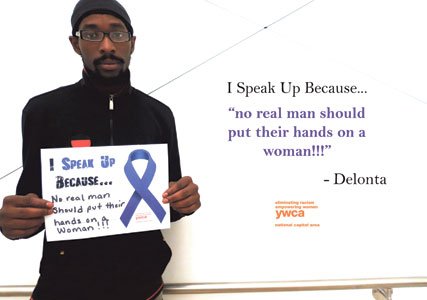While the YWCA is going purple in recognition of Domestic Violence Awareness Month, the nonprofit organization has easily become the largest provider of domestic violence services in the country.
(Courtesy of YWCA)
Survivor and former YWCA client Ieisha Haynes provides a poignant description of her life as a victim of domestic violence.
Also, the YWCA of Annapolis and Anne Arundel County offers a hotline that allows victims to connect with a trained advocate; a safe house for individuals and their children; adult and child counseling; legal services; support groups; and an abuser intervention program featuring a 28-week series that focuses on taking accountability for one’s actions as well as developing alternative options for coping with the issues that led to the violence in the home.
“More than 100 YWCA’s provide services or advocacy focusing on women and girl safety, especially domestic violence,” said Dara Richardson-Heron, CEO of YWCA USA.
“We provide assistance from the beginning all the way to court and we assist with employment training for domestic violence victims,” Richardson-Heron said. “We also train emergency room workers, police and first responders.”
The YWCA reports that 46 women are shot to death, every month by a current or former partner in domestic violence-related homicides while domestic violence overwhelmingly affects women regardless of their socioeconomic status, race, ethnicity or religion.
One in four women will experience a form of domestic violence at some point in their lives, and, on average, three women are murdered each day, the organization reported.
According to statistics obtained from the Bureau of Justice, domestic violence accounted for 21 percent of all violent victimizations from 2003 to 2012.
Intimate partner violence (15 percent) accounted for a greater percentage of all violent victimizations than violence committed by immediate family members (4 percent) or other relatives (2 percent) during that period.
Domestic violence includes: rape, sexual assault, robbery and aggravated and simple assault committed by intimate partners (current or former spouses, boyfriends or girlfriends), immediate family members (parents, children or siblings) or other relatives.
Current or former boyfriends or girlfriends committed most domestic violence between 2003 and 2012. This was true for both females (39 percent) and males (30 percent).
The majority of domestic violence was committed against females (76 percent), compared to males (24 percent), according to the Bureau of Justice.
A similar percentage of violence by intimate partners and immediate family members was reported to police (56 percent each), while about 49 percent of violence by other relatives was reported to police.
Finally, victims of intimate partner violence (24 percent) received more assistance from victim service agencies than victims of violence by immediate family members (18 percent) and other relatives (9 percent).
“About 1.4 million people connect with the YWCA annually [because of] domestic violence,” Richardson-Heron said. “We have extensive and robust programs. It’s a journey from victim to survivor to achiever. It’s a process.”
Locally, the YWCA offers a variety of programming to meet the social, emotional, educational and recreational needs of individuals in the area. Richardson-Heron said the programs are innovative, engaging and they follow best practices in their respective fields.
Richardson-Heron and other YWCA officials said it’s important not to blame the victim of domestic violence, even if they’ve chosen to stay in the home with the abuser.
“Financial empowerment is important and it’s one of the most common reasons women stay in an abusive relationship because they don’t have the economic means to do anything else,” she said.
However, the focus remains to help victims gain their independence as well as their financial footing and the YWCA has experienced its share of success in the area. The organization has experienced success in lobbying for policies that help curb domestic violence and policies that hold the perpetrators accountable.
“We do what’s necessary to help victims gain their strength and to rebuild themselves,” Richardson-Heron said. “Usually, they have to start all over and rebuild their credit and other things [to] rebuild their lives.”
If you are a victim of domestic violence, call 911. For more information about programs offered at the YWCA and for information, resources, facts and figures about domestic violence assistance, visit: www.ywca.orggopurple.

